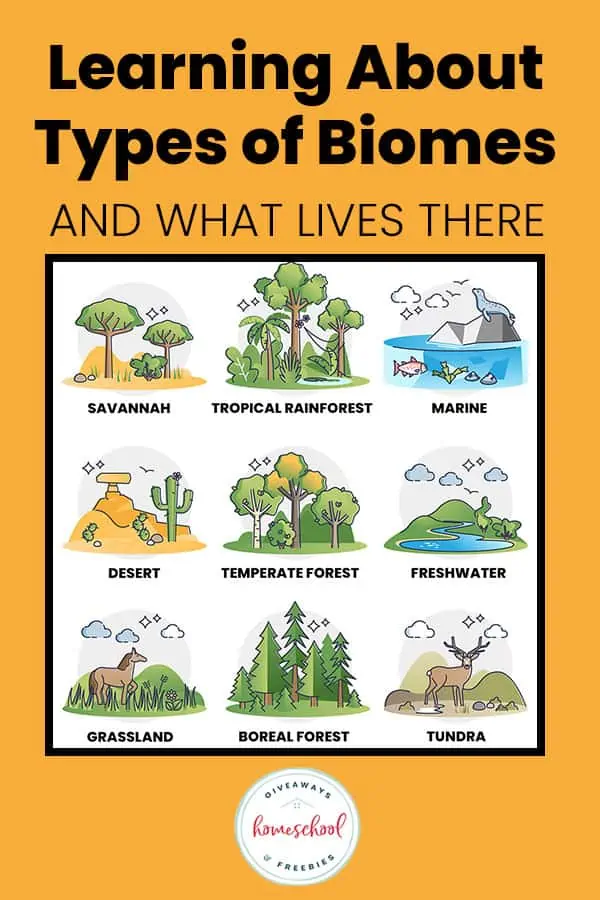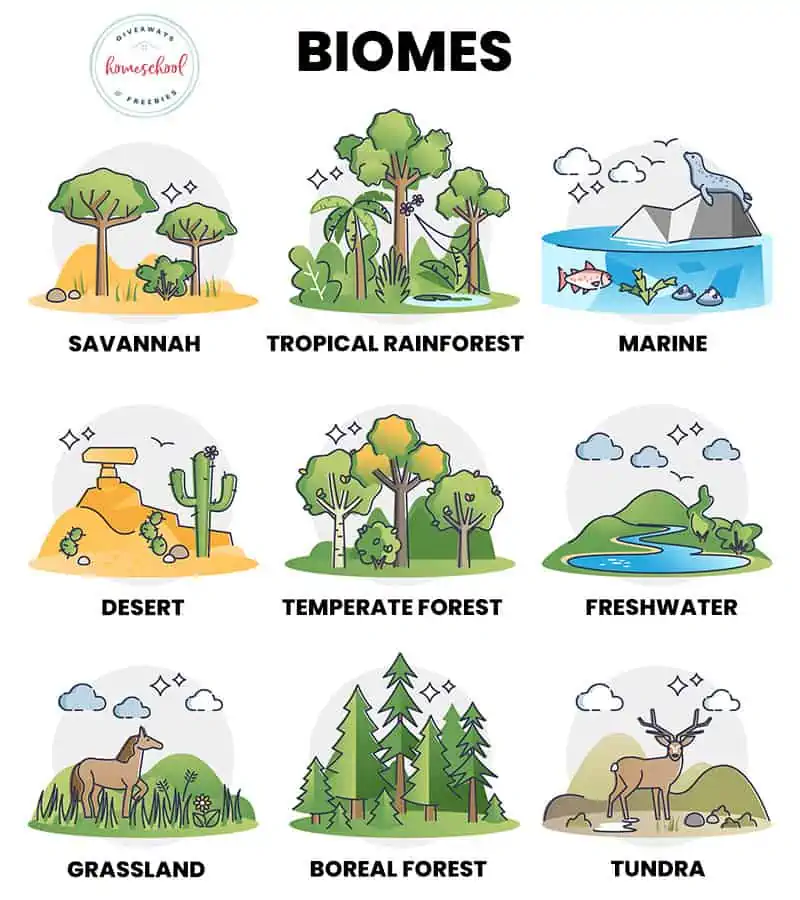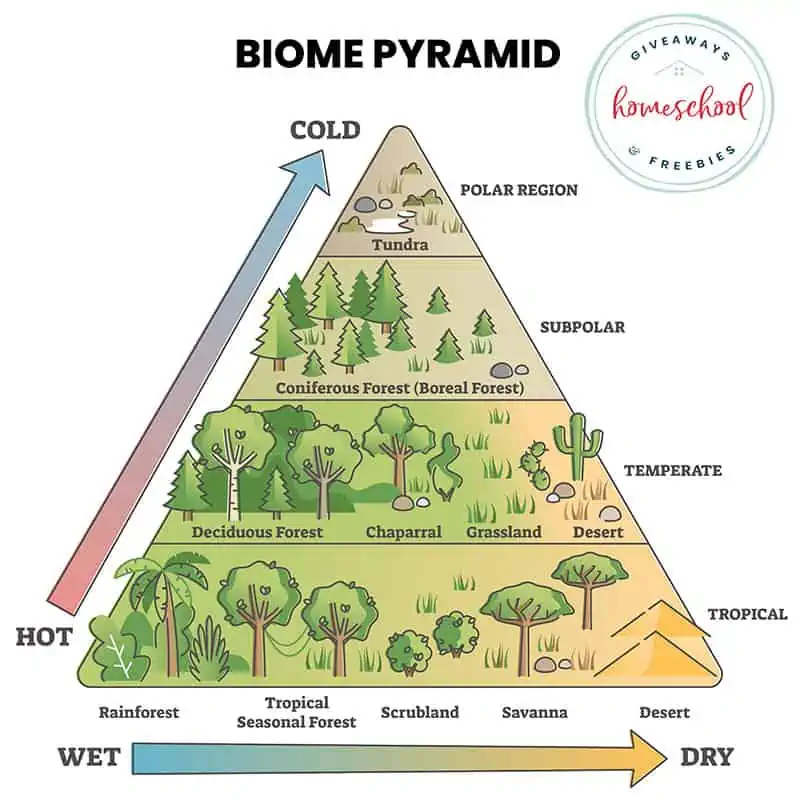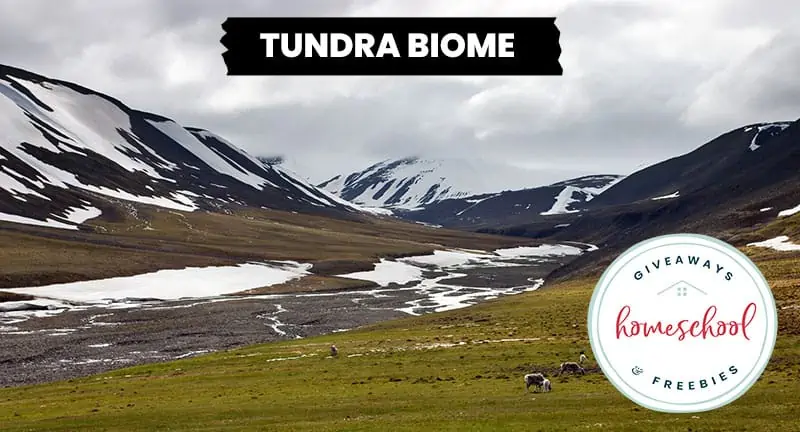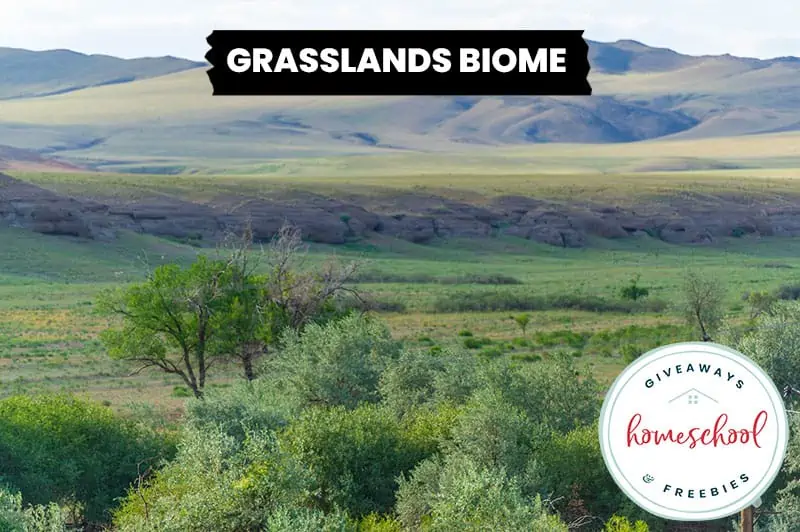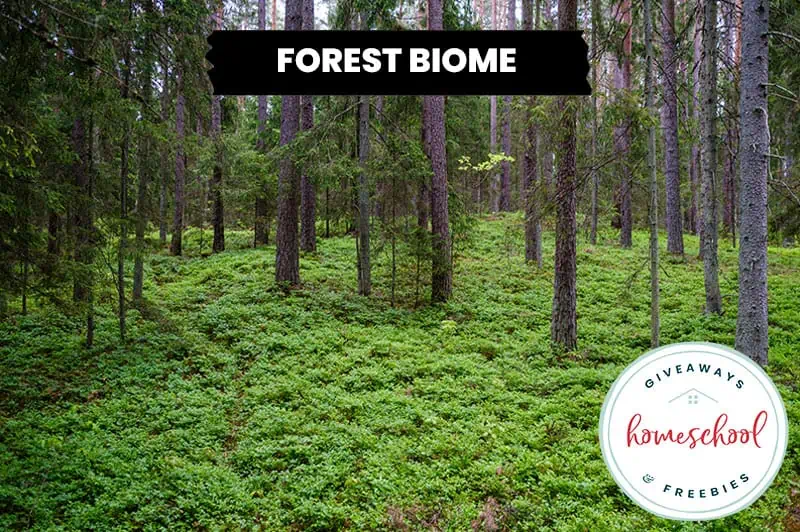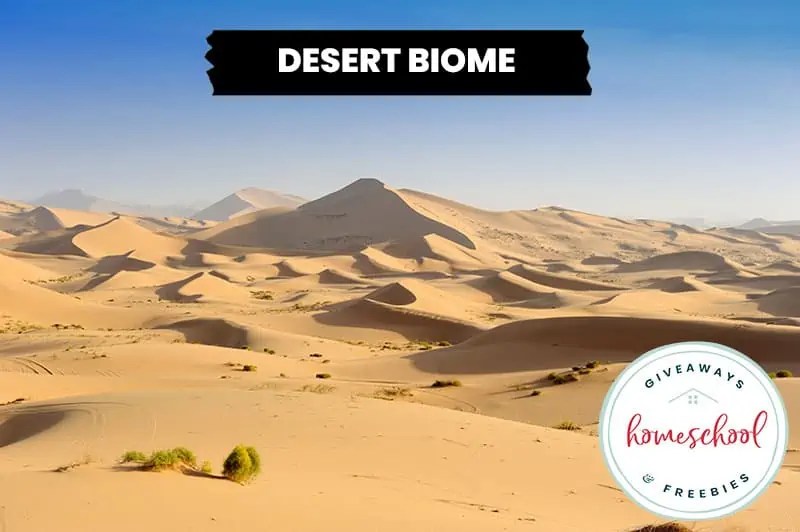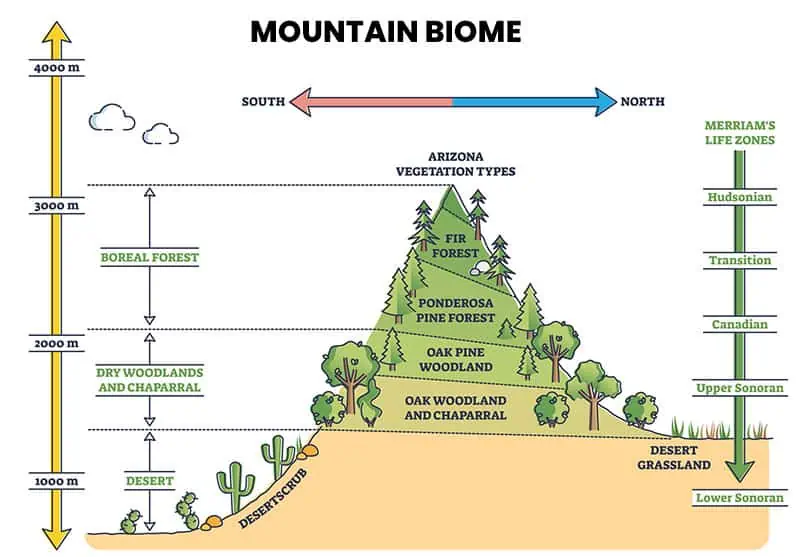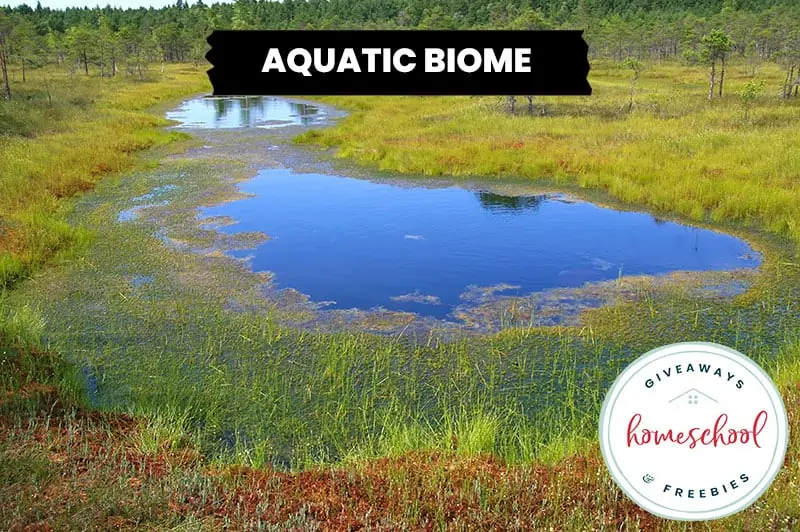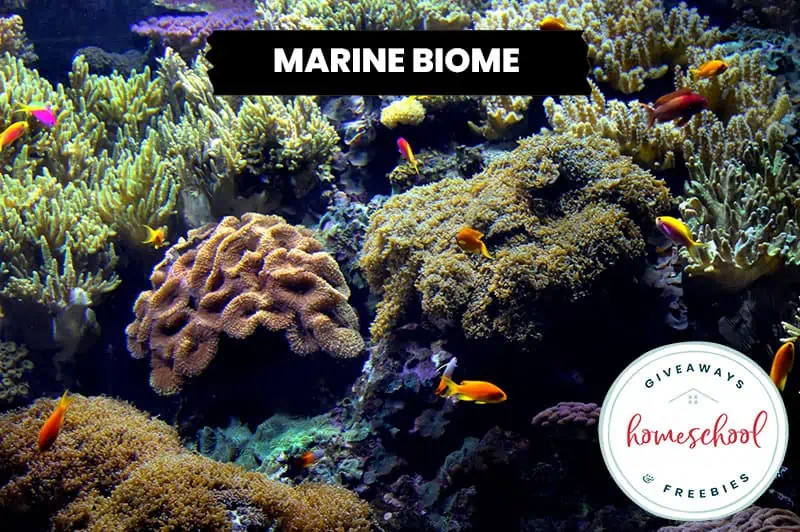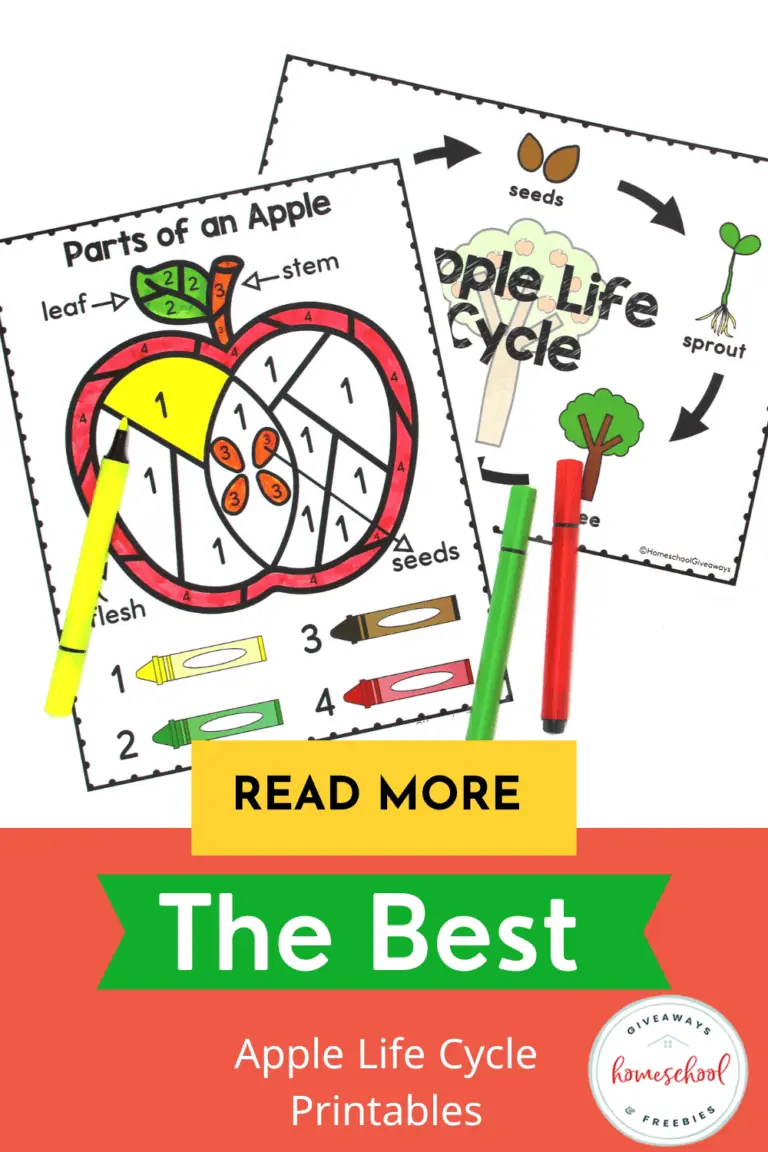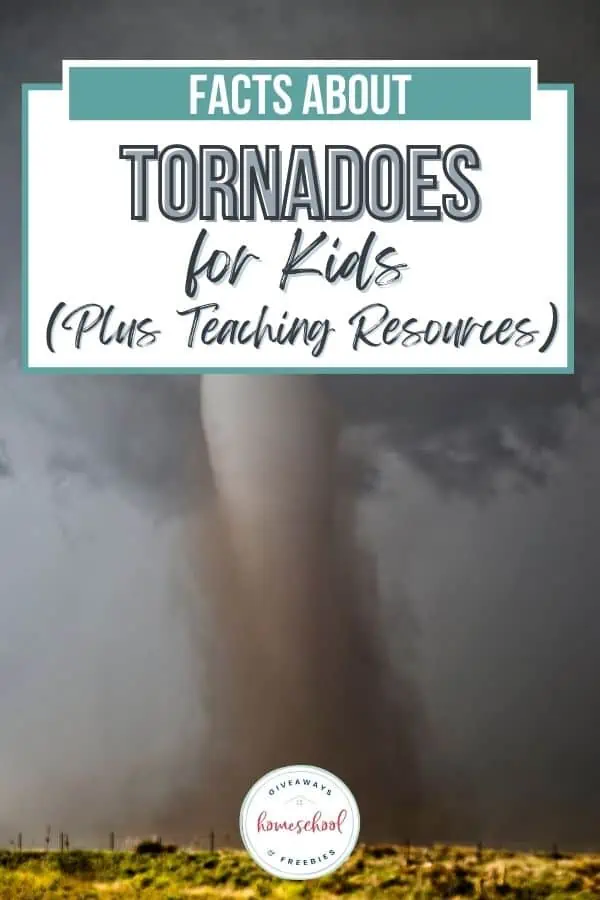Learning About Types of Biomes and What Lives There
Published:
May 10, 2022
Contributor:
Jeannette Tuionetoa
Disclosure: This post may contain affiliate links, meaning if you decide to make a purchase via my links, I may earn a commission at no additional cost to you. See my disclosure for more info.
It is quite amazing how living things develop and adapt to their environments. The Earth consists of environments within biomes that inhabit plant and animal species alike. Explore learning about types of biomes to take a deep dive into the habitats that cover our lands. You can access two free biome pdf downloads at the end of this post.
Types of Biomes
A biome is an ecosystem that is characterized by the plants and animals that live there as well as the climate, vegetation, and rainfall. Other things that contribute to a biome are geology and rainfall. A biome is different than an animal habitat.
Within a biome’s ecosystem, the animals and plants that inhabit learn to adapt to their climate and vegetation. In fact, an environment’s climate and vegetation amongst other characteristics determine the type of biome it is.
The Earth itself is considered one big biome, especially when it is viewed from space. Of course, it has been subdivided into additional biomes. Scientists separate biomes into two large biomes classified as terrestrial (land) biomes or aquatic biomes.
Within those two major biomes, there are five major biomes categorized as desert, grassland, tundra, aquatic, and forest. Amongst those five major biomes, there are others worth exploring within the major five.
Grab these resources to help you Teach Kids About Biomes:
Biome & Habitat Terminology Copywork Notebook – Learning through copywork helps students practice handwriting and gain knowledge from any subject. Add this useful resource to your lessons about biomes to enhance your students learning.
Habitat and Biome Notebooking Research Journal – This free resource will explore 16 different biomes and habitats students can explore through research and notebooking.
How do scientists classify biomes?
Scientists classify biomes by four different characteristics. The biome characteristics are climate, soil, living organisms, and vegetation. Knowing these differences allows us to determine what can survive and thrive in a certain environment.
The climate and soil of a biome determine what vegetation and which organisms are found in a particular biome. For instance, the animals and plants you would find in a dry desert won’t be found in a tropical rainforest where it is humid and rainy or the tundra where it is freezing cold.
Land Biomes
The land biomes of the world are also known as terrestrial biomes. Terrestrial biomes are characterized mainly by their temperatures (climate) and amount of precipitation. These two characteristics distinguish what type of vegetation and living organism occupy the biomes.
By the way, humans live on land biomes.
Tundra
The tundra region is the absolute coldest of all the biomes. For most of the year, the tundra landscape is frozen and cold. There is a short growing season (average six to ten weeks), so the harsh conditions mean the plants and animals alike have special adaptions to ensure they can survive there.
The other characteristics of the tundra include low biodiversity, simple vegetation, its dead organic material from the cold is used as energy and nutrients, then a large population of oscillations.
Different Types of Tundra
There are types of tundra: Arctic Tundra, Antarctic Tundra (the continent of Antarctica), and Alpine Tundra.
The Arctic Tundra is can be found in the northern hemisphere and surrounds the north pole.
Tundra Plant Life
Plant life in the Arctic Tundra doesn’t have a deep root system but has been made to withstand the cold climate, having about 1700 different types of plants. These include low shrubs, grasses, liverworts, reindeer mosses, lichen, and around 400 types of flowers.
Tundra Animal Life
Animals in the arctic are super diverse. There are herbivores like lemmings, squirrels, arctic hares, caribou, and voles. The carnivorous mammals include arctic foxes, wolves, and polar bears.
There are migrating birds that include ravens, falcons, snowbirds, loons, and more. There are insects like mosquitos, moths, grasshoppers, and arctic bumblebees. The fish include trout, flatfish, salmon, and cod.
Alpine Tundra
The Alpine Tundra depicts the mountains throughout the world at high altitudes. Of the sky in which no trees can grow. We usually know them unofficially as the snow cap mountains in a far distance.
The growing season usually lasts 180 days and the nights usually have below-freezing temperatures. The soil in this Tundra is well-drained and the plants are similar to the arctic tundra.
Animals who thrive in the alpine tundra are well adapted and they include mammals like pikas, mountain goats, sheep, and elk. They have grouselike birds only and insects like butterflies, grasshoppers, beetles, and springtails can be found in the alpines. Grab these animals of the tundra printables to learn more and this free animals of the taiga & tundra notebooking unit to put their learning into action.
Antarctic Tundra
The Antarctic Tundra biome climate is less harsh so more plants like moss, algae, and some grass can grow there. The winters are long, dark, and cold. Many scientists call Antarctica a cold desert or polar desert.
It is considered a desert because even though it is covered by frozen water or ice, the water is not available to help the biology of the land.
Grasslands Biome
When we look at large open fields of grass we experience the grasslands biome where animals graze and fires are likely, there is very low precipitation. Normally, they are found in the interiors of continents.
Grassland biomes are called different things depending on where they are located. In South America And Argentina grasslands are called pampas. In North America, they call grasslands prairies and in Russia and Asia, they are called steppes.
What is interesting is that although wildfires seem awful, in the grasslands, they are important and even essential to the grasslands ecosystems.
The grasslands adapt to the fires well as they grow back just fine afterward and even burrow underground until the flames are gone. God’s creation is truly incredible.
Savannas and Temperate Grasslands
There are two types of grasslands, temperate and savannas. Temperate grasslands have rich soil where grasslands grow abundantly and are found in North America and Eastern Europe. Savannas have a long dry season which helps trees grow and are located in South America, Australia, and Asia.
Common plants in the grasslands include sunflowers, crazy weeds, clovers, asters, and more. Common animals in this biome are bobcats, coyotes, eagles, wild turkeys, bison, dung beetles, and more. These grasslands animals printables are perfect for exploring these animals even more.
Forests Biome
Children may be familiar with forests, yet not understand how vital they are to our world’s ecology. Forests are the world’s most biodiverse of all the land/terrestrial biomes. They inhabit about 80% of all land species and cover about 1/3 of the Earth’s surface.
Forest biomes are vital to our Earth and the people on it. Forest trees provide oxygen production, and carbon dioxide reduction, prevent flooding and assist with climate regulation.
Forests produce food and materials to build, and even medicine which affects the livelihoods of almost 2 million people across the globe.
There are varying types of forest biomes, namely Tropical rainforest, Taiga (Boreal Forest), and Temperate forest.
Tropical Rainforests
Tropical rainforests hold 50% of all the species on the Earth, are near the equator, and have both a dry season and a wet season. They are found in Brazil, Peru, the Philippines, Cameroon, Sri Lanka, and Indonesia.
These forests have tall-growing trees (up to 115 ft) and are a moist forest climate that is home to many trees, plants, and animals. There are over 300 different species of trees in the rainforest alone.
Tropical rainforests have monkeys, exotic and colorful birds, frogs, reptiles, and large cats. Explore all about animals of the rain forest and resources to help your homeschool rainforest lessons.
Within the Tropical Forest category are different types of rainforests (i.e subtropical forests, dry tropical /deciduous forests, seasonal tropical forests, montane (cloud) forests, and coniferous tropical forests).
Subtropical Forests
Subtropical forests are north or south of tropical forests and are home to many evergreen and sem-evergreen trees because of their warm, humid climates. They have both rainy seasons and dry seasons.
Seasonal tropical forests have rainy seasons in the summer where they get monsoons and dry seasons during the winter months. These forests are near rainforests and are along the equator.
Montane or Cloud Forests
Montane or Cloud Forests are found in the mountainous regions in tropical areas. Clouds here for a canopy over the forest environment which makes it look misty or foggy. Trees here tend to be thicker and crooked. This environment has mountain gorillas, an endangered species.
Coniferous Tropical Forests
Coniferous tropical forests are dense with pine trees and confer. Butterflies and birds migrate here and they have elephants, bobcats, cougars, and more.
Deciduous Forests
Deciduous forests (tropical dry forests) shed their leaves due to the lack of rainfall. Some of these forests develop evergreen trees because they get just enough rainfall to prevent leaf shedding. These forests have parrots and other tropical birds, large cats, and monkeys.
Boreal Forests
Boreal forests also known as Taiga forests, encompass one of the world’s largest terrestrial biomes and can be found throughout Scandinavia, Siberia, and North America (i.e. Alaska and Canada).
These forests have an average temperature that is below freezing and have trees like conifers, spruce fire, and pine which all have significant roles in removing carbon dioxide from the atmosphere all around.
Most birds in the taiga forests migrate to warmer temperatures during the wintertime and other animals found here are large moose and deer. Learn more about the animals of the taiga with these printables.
Temperate Forests
Lastly, temperate forests can be found throughout eastern North America and Eurasia where the temperatures vary in the year because they have four different seasons. They have hot summers and cold winters, their seasons are winter, spring, summer, and fall.
Temperate forests have broadleaf trees like oaks, maple, and beech along with shrubs, perennial herbs, and mosses. In the fall leaves change color in the autumn (fall), they fall off during the winter, and then grow back during the spring.
There is large biodiversity of animals in the temperate forests biome. They range from insects, spiders, turtles, and salamanders to red pandas, dholes, American Black Bears, badger, wallaby, porcupine, fox, and more.
Check out these animals of the forest printables to help teach your students all about the animals who call the forest biome home.
Deserts Biome
Desert biomes make up about 30% of the Earth’s surface. Desert biomes can be found on every continent and have characteristics like lack of precipitation, extreme temperatures, and very little plant growth.
Animals in the Desert Biome
We know that all living things need water, yet in the desert biome animals are well adapted to survive the harsh environment. Whether it be icy cold landscapes or scorching heat and sandstorms, living in deserts is challenging at best.
Plants and animals are adapted to these extremes. For instance, a cactus has enlarged stems to store more water and it is spiked so animals can’t steal the water from them.
African bullfrogs burrow into the ground until rainfalls and many other desert animals have elongated ears to release heat from their bodies.
Desert Classifications
There are four main desert classifications that include hot or cold or semi-arid or coastal deserts.
Semi-arid Deserts
Semi-arid deserts are hot and dry having temperatures that are warm and dry all year-round. The Sahara Desert in Africa and the Mohave desert in southwest North America are both semi-arid. They are found in Africa, North America, Greenland, Europe, and Asia.
Coastal Deserts
Coastal deserts are humid but because heavy fogs blowing from the coast they still lack rainfall most of the time. Examples of a coastal deserts are the Atacama Desert of Chile in South America and the Namib desert of South America.
Cold Deserts
Cold deserts (temperate deserts) surprise many kids, but cold deserts are still dry although they might look moist because of all the ice. The ice doesn’t melt, so it is dry and very cold. Antarctica is just one large cold desert (polar desert) because of the lack of rainfall. As a matter of fact, the polar deserts of the Arctic and Antarctica are the two largest deserts on Earth.
Cold deserts occur in higher latitudes, they are far from oceans and of course, have cooler temperatures. Another example of a temperate or cold desert is the Gobi Desert in central Asia.
Hot Deserts
Hot deserts are also called subtropical deserts and are very hot and dry. They are usually found at low latitudes in the southern or northern areas from the equator.
Animals that occupy the desert are Bactrian camels (two humps), bats, bighorn sheep, dromedary camels (one hump), iguanas, scorpions, and more. Some flora that grows in the desert is barrel cactus, prickly pear cactus, sagebrush, and palm tree.
Mountains Biome
The Mountain Biome is also known as the Alpine biome and is found in mountain regions across the globe. They include the Andes, the Alps, and the Rocky Mountain ranges.
Normally, as the altitude increases the temperature decreases, the higher you get the colder it gets. The temperatures in these biomes can many times change from warm to absolutely freezing all in one day.
Plants in the Mountain Biome
Unlike other biomes, the mountain biome environment is not an easy place for plant life to form. It gets really windy, and cold while the sunlight is extremely intense. This is why there are only about 200 different species of plants that grow there.
The high altitudes produce very little carbon dioxide which is a crucial component of photosynthesis plants need to survive. Some plants here are dwarf trees, tussock grasses, small-leaf shrubs, and bristlecone pine (this pine can live up to 4,000 years).
Animals in the Mountain Biome
It is not easy living in cold, windy places with the extreme sun beaming UV rays. The animals that live here often hibernate or migrate to warmer areas.
Animals tend to have similar characteristics that adapt them to this type of weather like short legs, tails, and ears to help reduce the sun’s heat at high altitudes. These animals also tend to have larger lungs and more blood vessels that help them deal with the low levels of oxygen at the high altitudes.
Some animals in mountainous biomes are mountain goats, sheep, elk, grasshoppers, and butterflies. The chinchilla is also an animal that lives here and is considered an endangered species. Grab these free mountain animals coloring and copywork resources to go alongside your lessons.
Aquatic Biome
The aquatic biome is the largest biome on the planet Earth. In fact, water covers about 75% of the globe. Kids are always astonished about that percentage. It is easy to think about how much landmass there is on Earth but realizes that water more than doubles that amount.
What’s in the aquatic biome?
The aquatic biome is comprised of ponds, lakes, streams, rivers, wetlands, and marine regions such as coral reefs, oceans, and estuaries. The aquatic biome can be further subdivided into freshwater and marine categories.
Freshwater Biome
The smaller portion of aquatic biomes is freshwater which consists of lakes, ponds, wetlands, and streams. Freshwater biomes make up about .8 % of all the water on the planet. These freshwater biomes are found within the land biomes of the Earth.
The climate of these different types of bodies of water depends on how deep the water gets. Temperatures drop the deeper the water gets, therefore since lakes have less movement they go deeper than streams or rivers.
Ponds and Lakes
Ponds and lakes are bodies of water oftentimes referred to as lentil ecosystems because they have standing or still waters. They are a large community filled with plants and animals, or flora and fauna.
Fauna (animals) that live in ponds and lakes are all different types of fish species, insects, worms, frogs, turtles, and more. Plants in this environment are lilies, cattail, duckweed, stonewort, and others.
Streams and Rivers
Streams and rivers are very different from lentil ecosystems in that they have moving waters and so are called lotic ecosystems. These are considered lotic ecosystems, whether they are tiny streams that trickle or mile-wide rivers that flow for thousands of miles.
The various animal species living in streams or rivers include crocodiles, different types of fish, snails, crabs, insects, salamanders, otters, snakes, and beavers.
The plants or flora that live in them are populated along its river banks and edges where the water doesn’t flow so quickly. The plants include tape grass, star grass, willow trees, and river birch.
Wetlands
The wetlands biome is a combination of freshwater and land. Basically, it is land saturated with water. If you ever lived in Florida you know what this is; it includes swamps, marshes, and bogs. Add these animals of freshwater marshes printables to your freshwater lessons.
Wetlands are interesting in that they can help in the mitigation of flooding, and even purify or filter water.
Plants in the wetlands are water lilies, milkweed, mangroves, cypress trees, and cattails. Animals that inhabit the wetlands are crocodiles, alligators, raccoons, deer, minks, and beavers.
Marine Biome
The marine biome covers most of the Earth’s three-quarter water mass. The marine biome is sometimes considered one of the most important because of its biodiversity. Biodiversity is the different types of living organisms within that biome.
Ecosystems in the Marine Biome
In the marine biome, you will find various types of ecosystems including oceans, coral reefs, and estuaries all of which are saltwater environments.
Within this biome, there are gulfs, bays, and five major oceans: the Pacific Ocean, the Atlantic Ocean, the Arctic Ocean, the Indian Ocean, and the Southern Ocean.
Plants and Animals in the Marine Biome
The marine biome has a wide and varying amount of living organisms and algae. Marine biomes biodiversity starts here with animals that range from fish like sharks, swordfish, stingrays, and seahorses, to marine mammals like blue whales, dolphins, manatees, seals, and more. The biome also is home to mollusks, oysters, slugs, snails, clams and so much more.
Plant Species in the Marine Biome
There are thousands of different species of plants in the marine biome which rely on photosynthesis from the sun for their source of energy just like land plants. Some plant types are algae, like kelp and phytoplankton, seaweeds, seagrass, and mangroves as well.
Healthy oceans are actually critical to life on land. For instance, the algae in the oceans give the world large amounts of oxygen and absorb carbon dioxide much the way trees on land supply us with oxygen and absorb carbon dioxide.
Interesting Facts about Biomes
Here are some interesting facts about biomes that students will enjoy while studying biomes at home.
- Tropical rainforests supply 70% of the plants needed for medicine that helps fight and treat cancer and diseases identified by the US National Cancer Institute.
- The grassland biomes are inhabited by the largest land animals on the planet like giraffes, bison, elephants, and rhinoceroses.
- Need some shade? Well, less than 2% of sunlight can actually reach the ground in the tropical rainforests because of the canopy of trees that can reach as tall as 150 ft.
- The sap on the trees in the temperate forests helps them adapt to the harsh winter conditions.
- The ocean is absolutely enormous. 90% of the marine biome in the ocean doesn’t receive sunlight. Most of the species in the ocean live beyond where the sunlight reaches.
- There are actually different zones in the ocean like the midnight zone and the twilight zone. In the twilight zone, most species make their own light called bioluminescence.
- The largest mammal in the world can be found in the marine biome, the blue whale.
- The desert can seem too dry for people to live in, but over 1 billion people live in desert areas.
- One-third of the world’s carbon dioxide comes right from the Arctic Tundra soil. The frozen soil there is called permafrost and is important to carbon and the cycle of nutrients in the atmosphere.
Caring for Earth’s Biomes
Human activities have definitely impacted and altered various biomes. Whether it be a small scale or large scale effect on the biomes, it is essential that children understand and be aware of how.
People have influenced environments enough that some scientists have labeled this current era the Anthropocene. This means the geological age dominated by human activity has an impact on climate and the environment.
The forest biome has been most at risk for human impact by development, deforestation from logging, power generation, agriculture, and the paper industry.
We understand that humans living in nature develop consequences and impacts. It is beneficial that children not be consumed by this but just made aware of simple actions to take to help the environment around us.
Families can plant trees, learn to conserve water, recycle, buy less plastic, try to grow our own foods, and so much more.
Free Biome PDF Downloads
Biome & Habitat Terminology Copywork Notebook – Do your kids know what the differences are between tundra and taiga or tropical dry forests and tropical rain forests? This free Biome & Habitat Terminology Copywork Notebook can help!
Biome and Habitat Notebooking Research Journal – Help your kids discover 16 biomes and habitats with this free Biome and Habitat Notebooking Research Journal.

